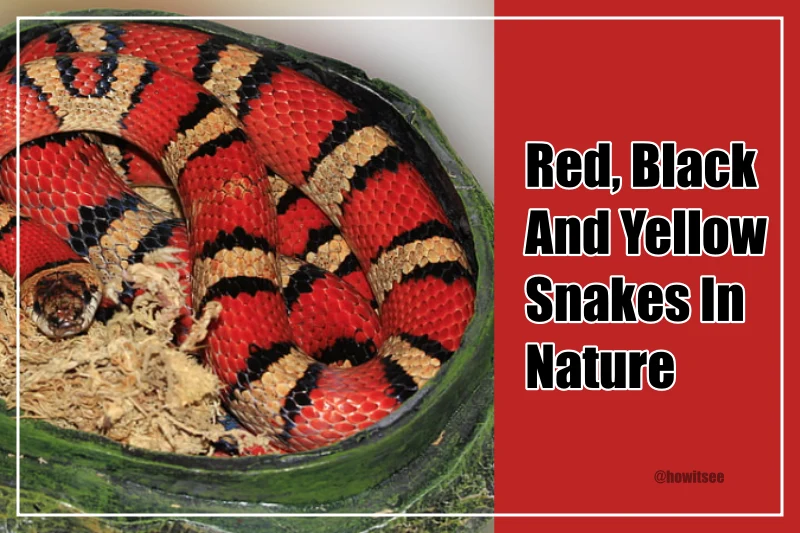Snakes are fascinating creatures that have existed on Earth for a long time. There are around 3,400 species of snakes in the world. They are known for their unique shape, size, and color. Some are venomous some are not. The red, black, and yellow combination sounds weird, but it exists in animals, especially snakes.
Some snakes evolved in such a way, and some mimic it to avoid predators. In this article, you will learn about some of these ex*tic red, black, and yellow snakes in nature.
14 Red, Black, and Yellow Snakes
1. Eastern Coral Snake
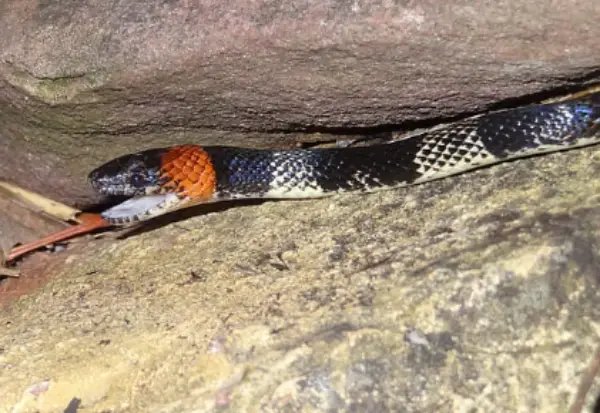
| Scientific name | Micrurus fulvius |
| Size | 80 cm to 122 cm |
| Diet | Carnivore |
| Geographical location | Southeastern United States |
This highly venomous snake is endemic to the southeastern United States. They are long and can reach a length of 80 cm to 122 cm. It has a glossy appearance with bright red, black, and yellow band patterns.
They are often mistaken for scarlet kingsnakes due to their appearance. Their venom is highly neurotoxic; it can even paralyze a person.
They mostly live underground, which is why they are uncommon. They lay around 7-8 eggs in early summer, which get hatched in late summer.
2. Texas Coral Snake
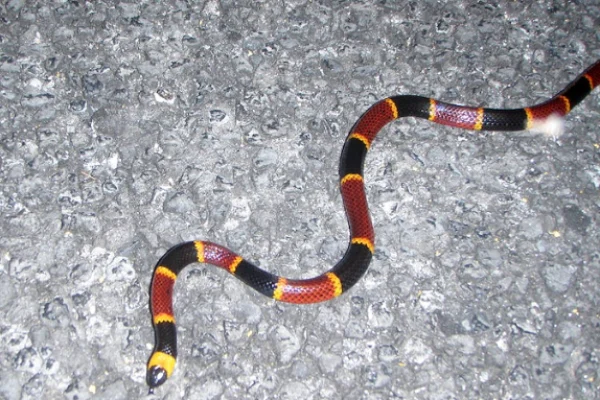
| Scientific name | Micrurus tener |
| Size | 122 cm |
| Diet | carnivore, cannibalistic |
| Geographical location | Southern United States, Central Mexico |
Micrurus tener is one of the venomous snakes found in the southern United States and central Mexico. Like other coral snakes, they also have that characteristic red, black, and yellow band pattern. The yellow band pattern is somewhat broader than others.
Females are comparatively larger than males. Their neurotoxic venom affects the neuromuscular junction and causes paralysis. Its venom is considered the second-most dreadful in the world.
This cannibalistic snake is shy and secretive and is sometimes found under tree logs.
3. Amazon Tree Boa
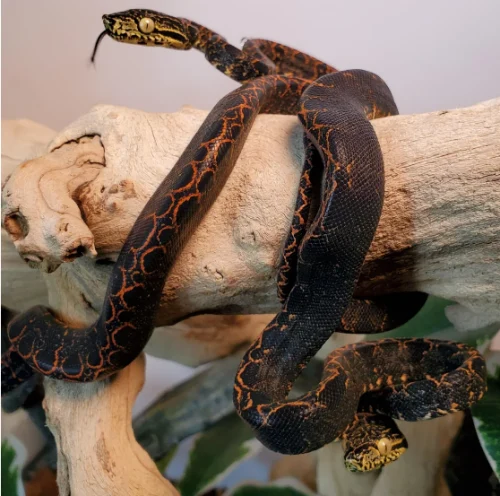
| Scientific name | Corallus hortulana |
| Size | 1..5-2 m |
| Diet | Carnivore |
| Geographical location | South America, including Brazil, Venezuela, Colombia, and Peru |
This venomous snake occurs in different colors in nature, called phases. They are quite long, with a size of 1.5–2 m, and are found in South America. The Amazon tree boa is solitary, nocturnal, and lives mostly on trees.
They are ovoviviparous, which means they lay eggs, hatch internally, and give live birth. They can sense heat by using heat-sensing pits. These snakes are known to be very aggressive.
4. Corn snake
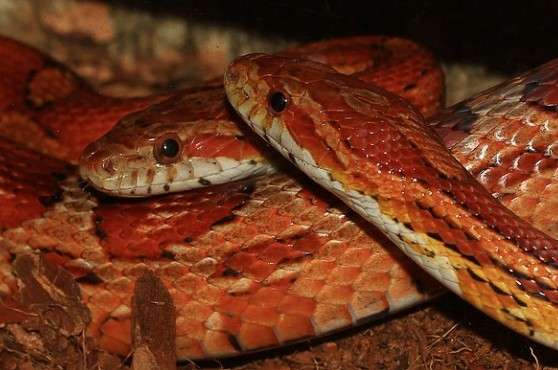
| Scientific name | Pantherophis guttatus |
| Size | 61-182 cm |
| Diet | carnivores |
| Geographical location | Southeastern and Central United States |
The red rat snake, a North American native snake, is non-venomous and harmless. This snake is known for its distinctive characteristics and has an orange or red body with yellow spots and black markings.
They are diurnal and can attain sizes up to 61–182 cm. They are powerful and kill their prey by constriction. It is often used as a biocontrol agent to control rodent pests.
5. Aquatic coral snake
| Scientific name | Micrurus surinamensis |
| Size | 80-100 cm |
| Diet | Carnivores |
| Geographical location | South America |
This semi-aquatic snake is one of the heaviest coral snakes found in northern South America. They have characteristic long snouts, and their eyes are more dorsally present than other coral snakes.
It has distinctive red, yellow, and black band patterns all over the body, like coral snakes. They use their cryptic coloration as a defense mechanism.
6. California Red-sided garter snake
| Scientific name | Thamnophis sirtalis infernalis |
| Size | 55-100 cm |
| Diet | Carnivore |
| Geographical location | North America |
As the name indicates, the California red-sided garter snake is endemic to California and found inhabiting coastal ranges.
This medium snake has a body length that ranges from 55 to 100 cm. Females are larger than males and have a distinctive black-stripy appearance with red and yellow spots.
According to recent research, they are venomous. They are viviparous snakes, and females can give birth to 8 to 10 snakelets. They are considered rare and threatened in certain areas.
7. Eastern Hognose Snake
| Scientific name | Heterodon platirhinos |
| Size | 76-116 cm |
| Diet | Carnivore |
| Geographical location | Eastern half of the United States, Georgia, and South Carolina |
You can find this hog-nosed snake in North America, inhabiting pine forests, old fields, and forest edges. They have distinctively upturned snouts, which they used to dig the soil.
Depending upon their surroundings, they have different color combinations in their bodies, like black, brown, red, yellow, orange, etc.
Like cobras, they raise their heads when they feel threatened. They are very fond of amphibians, especially toads, to feed on.
According to COSEWIC, they are considered a threatened species. Females lay up to 8–10 eggs, and parental care is absent in this species. They are usually used as exotic pets.
8. Ground Snake
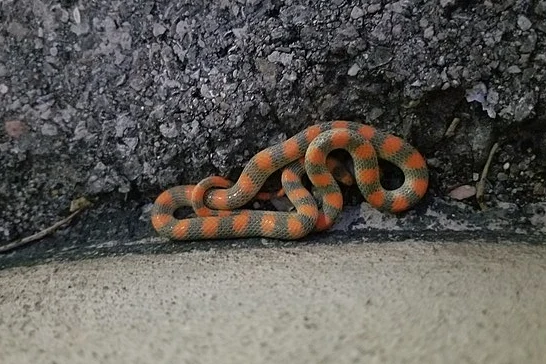
| Scientific name | Sonora semiannulata |
| Size | 8 to 19 inches |
| Diet | Omnivore |
| Geographical location | Southwestern United States, Northern Mexico |
It is also known as a miter snake due to the markings on its head that resemble bishop miters. The most distinctive feature of this non-venomous snake is its thick head. This North American snake has a variety of colors, including red, black, yellow, orange, etc.
They show color polymorphism and cryptic coloration to avoid predators. Because of their small size, shy temperament, and non-venomous nature, they are considered harmless to human beings.
They are kept as pets due to their small size and low management costs. Let’s talk about their diet. They are omnivores and prefer to feed on centipedes, crickets, spiders, and insects.
9. Rainbow Snake
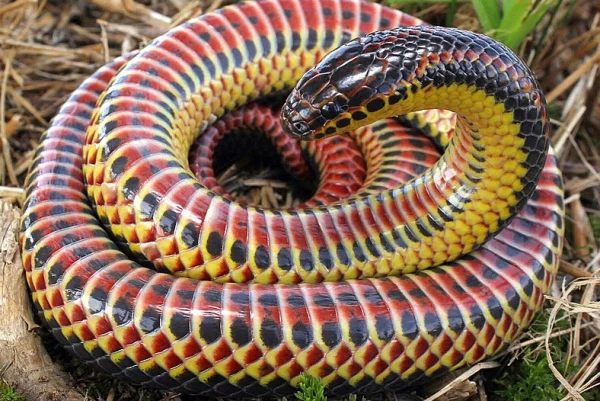
| Scientific name | Farancia erytrogramma |
| Size | 91-122 cm |
| Diet | Carnivore |
| Geographical location | Southeastern United States |
As the name indicates, they are also colorful like a rainbow means they occur in many morphological forms. These non-venomous aquatic snakes occur in the southern United States.
They are the most beautiful snakes in the world, having three red stripes all over their black bodies and yellow markings under their heads. Their females are larger than their males and lay up to 50 eggs that get hatched in late summer.
10. Sonoran Coral snake
| Scientific name | Micruroides euryxanthus |
| Size | 28-61 cm |
| Diet | Carnivore |
| Geographical location | Central Arizona, Southwestern Mexico |
These small snakes can attain a size of up to 28–61 cm. Like other coral snakes, they also have red and black alternate bands, which are separated by thin yellow or white bands.
This carnivore snake is found in central Arizona and southwestern Mexico, inhabiting arid and semi-arid regions. They are known for their neurotoxic and potent venom.
11. Honduran milk snake
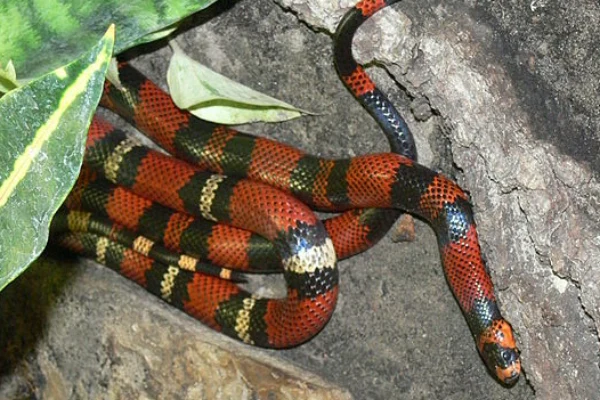
| Scientific name | Lampropeltis triangulum |
| Size | 48 inches |
| Diet | Carnivore, Ophiophagous |
| Geographical location | Subtropical regions of Honduras, Nicaragua, and Costa Rica |
This non-venomous and colubrid snake is one of the largest milk snakes in the world and can reach up to a length of 48 inches.
They show Batesian mimicry and have the same coloration as coral snakes to avoid predators. As they are non-venomous, they use constriction to kill their prey. They are oviparous females can lay up to 3 to 18 eggs in June.
Now about their diet: they are ophiophagous and sometimes show cannibalism. They are the first choice of snake lovers because of their impressive coloration and low maintenance.
12. Scarlet Kingsnake
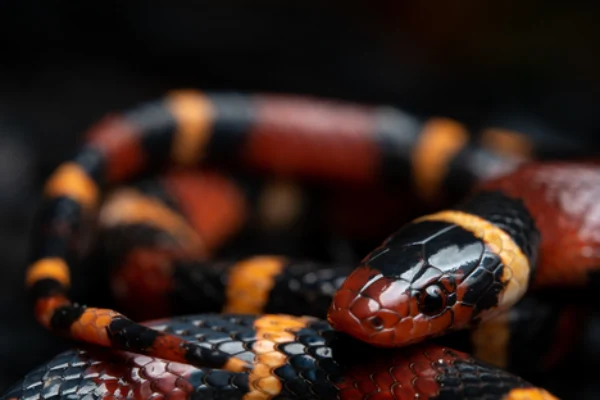
| Scientific name | Lampropeltis elapsoides |
| Size | 40-50 cm |
| Diet | Carnivore |
| Geographical location | Southeastern and Eastern United States |
They may look like an Eastern Coral snake, but it is a Scarlet King snake. They have a similar appearance to coral snakes, with the same red, yellow, and black band patterns.
Often considered excellent climbers and can climb trees or buildings. This nocturnal, non-venomous snake often feeds on lizards or other small snakes.
They lay around 2–8 eggs in piles of debris. There is a rhyme for scarlet kingsnakes, unlike coral snakes: “If red touches black, it is a friend of Jack.”
13. Scarlet snake
| Scientific name | Cemophora coccinea |
| Size | 36-66 cm |
| Diet | Carnivore |
| Geographical location | Southeastern U.S. |
They have a similar appearance to scarlet king snakes, but their pale yellow stripes do not touch. Their midbody has a row of 19 smooth scales. They used their pointed red snout to dig the burrows.
This non-venomous snake is not as aggressive as it appears to be. According to North Carolina records, they can attain a maximum length of up to 84 cm.
You can find this snake in the southern US, inhabiting forested areas. They are considered endangered species, and their numbers are decreasing rapidly due to habitat loss and a high mortality rate in several places.
14. Desert shovel-nosed snakes
| Scientific name | Chionactis annulata annulata |
| Size | 15 inches |
| Diet | Carnivore |
| Geographical location | Western and south-central Arizona |
As the name indicates, they have a flattened, shovel-shaped snout. These snakes have a yellowish body with black bands encircling the body, and red blotches are also present all over the body.
This nocturnal, non-venomous species likes to feed on invertebrates, especially insects, spiders, etc. Their numbers are rapidly decreasing with time.
Conclusion
In conclusion, these red, black, and yellow snakes have a distinctive and beautiful appearance. They can be venomous or non-venomous. This group of snakes shows cryptic coloration to avoid predators.
They are famous among snake enthusiasts due to their bright, irresistible appearance. We will come up with another snake-related article, but until then, you must read about these snakes.
Also Read:

Being a zoology student I’m always been fascinated toward animals especially insects. I love to do research and learn about different animals. As a writer I want to share my thoughts about nature through my articles. Apart from this you can find me exploring the new places and voice notes.
